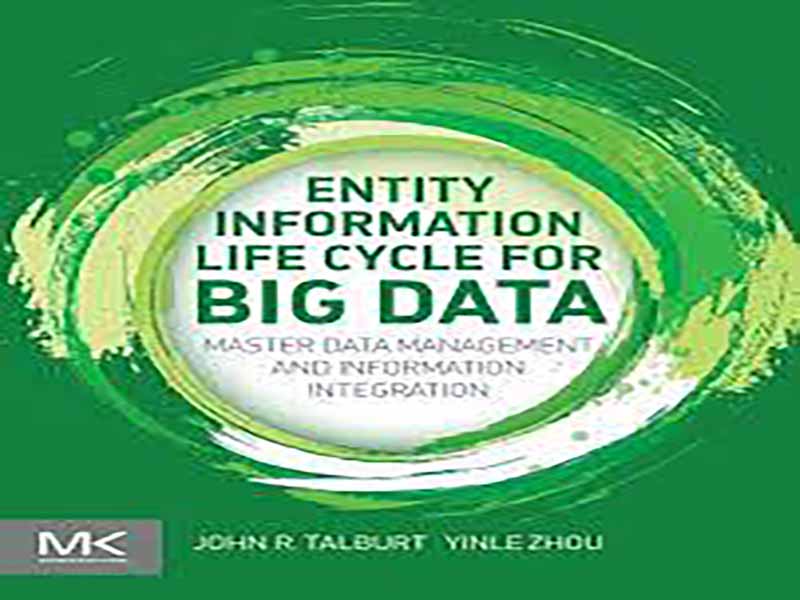- عنوان کتاب: Entity Information Life Cycle for Big Data
- نویسنده: John R. Talburt
- حوزه: کلان داده
- سال انتشار: 2015
- تعداد صفحه: 238
- زبان اصلی: انگلیسی
- نوع فایل: pdf
- حجم فایل: 6.51 مگابایت
از زمان انتشار Entity Resolution and Information Quality (Morgan Kaufmann, 2011)، اتفاقات زیادی در زمینه اطلاعات و کیفیت داده ها افتاده است. یکی از مهم ترین پیشرفت ها این است که چگونه سازمان ها شروع به درک این موضوع می کنند که داده هایی که در اختیار دارند جزو مهم ترین دارایی های آنهاست و باید بر این اساس مدیریت شوند. همانطور که بسیاری از ما می دانیم، این به هیچ وجه یک پیام جدید نیست، فقط در حال حاضر به آن توجه می شود. کارشناسان برجسته در زمینه کیفیت اطلاعات و داده ها مانند ریچ وانگ، یانگ لی، تام ردمن، لری انگلیسی، دانت مک گیلورای، دیوید لوشین، لورا سباستین-کلمن، راجش جوگولوم، سونیل سوآرس، آرکادی میدانچیک و بسیاری دیگر از این اصل حمایت کرده اند. خیلی سال. شواهد این درک جدید را می توان در افزایش چشمگیر پذیرش برنامه های حاکمیت داده (DG) توسط سازمان ها در هر نوع و اندازه یافت. کنفرانس ها، کارگاه ها و وبینارها در مورد این موضوع مملو از شرکت کنندگان است. دلیل اصلی این است که DG به سازمانها پاسخی برای این سوال ارائه میکند: «اگر اطلاعات واقعاً یک دارایی مهم سازمانی است، پس چگونه میتوان آن را در سطح سازمانی مدیریت کرد؟» یکی از مزایای اولیه برنامه DG این است که چارچوبی برای اجرای یک نقطه مرکزی ارتباط و کنترل بر تمام داده ها و اطلاعات یک سازمان فراهم می کند. با رشد و بلوغ DG، اجزای اساسی آن به وضوح مشخص می شوند. این مؤلفه ها عموماً شامل مخازن مرکزی برای تعاریف داده، قوانین تجاری، ابرداده، ردیابی مسائل مربوط به داده، مقررات و انطباق، و قوانین کیفیت داده می شود. دو جزء کلیدی دیگر DG عبارتند از مدیریت داده اصلی (MDM) و مدیریت داده مرجع (RDM). در نتیجه، پذیرش فزاینده برنامههای DG افزایش متناسبی را در تمرکز بر اهمیت MDM ایجاد کرده است. مطمئنا این اولین کتاب در مورد MDM نیست. چندین کتاب عالی عبارتند از مدیریت داده ها و مدیریت داده ها توسط الکس برسون و لری دوبوف (2011)، مدیریت داده ها در عمل توسط دالتون سروو و مارک آلن (2011)، مدیریت داده های کارشناسی ارشد توسط دیوید لوشین (2009)، مدیریت داده های ارشد سازمانی توسط آلن دریبلبیس، ابرهارد هچلر، ایوان میلمن، مارتین اوبرهوفر، پل ون ران و دن ولفسون (2008) و ادغام داده های مشتری توسط جیل دایچ و ایوان لوی (2006). با این حال، MDM یک موضوع گسترده و در حال تکامل است. هیچ کتابی نمی تواند تمام جنبه های MDM را در هر سطحی بررسی کند.
Since the publication of Entity Resolution and Information Quality (Morgan Kaufmann, 2011), a lot has been happening in the field of information and data quality. One of the most important developments is how organizations are beginning to understand that the data they hold are among their most important assets and should be managed accordingly. As many of us know, this is by no means a new message, only that it is just now being heeded. Leading experts in information and data quality such as Rich Wang, Yang Lee, Tom Redman, Larry English, Danette McGilvray, David Loshin, Laura Sebastian-Coleman, Rajesh Jugulum, Sunil Soares, Arkady Maydanchik, and many others have been advocating this principle for many years. Evidence of this new understanding can be found in the dramatic surge of the adoption of data governance (DG) programs by organizations of all types and sizes. Conferences, workshops, and webinars on this topic are overflowing with attendees. The primary reason is that DG provides organizations with an answer to the question, “If information is really an important organizational asset, then how can it be managed at the enterprise level?” One of the primary benefits of a DG program is that it provides a framework for implementing a central point of communication and control over all of an organization’s data and information. As DG has grown and matured, its essential components become more clearly defined. These components generally include central repositories for data definitions, business rules, metadata, data-related issue tracking, regulations and compliance, and data quality rules. Two other key components of DG are master data management (MDM) and reference data management (RDM). Consequently, the increasing adoption of DG programs has brought a commensurate increase in focus on the importance of MDM. Certainly this is not the first book on MDM. Several excellent books include Master Data Management and Data Governance by Alex Berson and Larry Dubov (2011), Master Data Management in Practice by Dalton Cervo and Mark Allen (2011), Master Data Management by David Loshin (2009), Enterprise Master Data Management by Allen Dreibelbis, Eberhard Hechler, Ivan Milman, Martin Oberhofer, Paul van Run, and Dan Wolfson (2008), and Customer Data Integration by Jill Dyche´ and Evan Levy (2006). However, MDM is an extensive and evolving topic. No single book can explore every aspect of MDM at every level.
این کتاب را میتوانید از لینک زیر بصورت رایگان دانلود کنید:

































نظرات کاربران